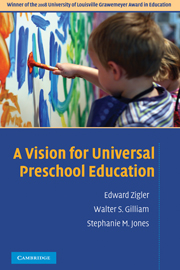49 results
20 - Intelligence and Cognitive Exceptionality
- from Part II - Domains of cognition in context
-
-
- Book:
- Cognition and Motivation
- Published online:
- 18 December 2013
- Print publication:
- 19 November 2012, pp 433-449
-
- Chapter
- Export citation
Contributors
-
-
- Book:
- Cognition and Motivation
- Published online:
- 18 December 2013
- Print publication:
- 19 November 2012, pp xi-xviii
-
- Chapter
- Export citation
Commentary: Are We Promising Too Much for Preschool Education Programs?
-
-
- Book:
- Childhood Programs and Practices in the First Decade of Life
- Published online:
- 05 June 2012
- Print publication:
- 23 August 2010, pp 235-240
-
- Chapter
- Export citation
Resilience is not a unidimensional construct: Insights from a prospective study of inner-city adolescents
-
- Journal:
- Development and Psychopathology / Volume 5 / Issue 4 / Fall 1993
- Published online by Cambridge University Press:
- 09 September 2009, pp. 703-717
-
- Article
- Export citation
Premorbid competence, thought-action orientation, and outcome in psychiatric patients with mild mental retardation
-
- Journal:
- Development and Psychopathology / Volume 8 / Issue 3 / Summer 1996
- Published online by Cambridge University Press:
- 04 March 2009, pp. 585-595
-
- Article
- Export citation
Intelligence and social competence among high-risk adolescents
-
- Journal:
- Development and Psychopathology / Volume 4 / Issue 2 / April 1992
- Published online by Cambridge University Press:
- 31 October 2008, pp. 287-299
-
- Article
- Export citation
Summary and Recommendations
-
- Book:
- A Vision for Universal Preschool Education
- Published online:
- 05 June 2012
- Print publication:
- 10 July 2006, pp 262-270
-
- Chapter
- Export citation
List of Contributors
-
- Book:
- A Vision for Universal Preschool Education
- Published online:
- 05 June 2012
- Print publication:
- 10 July 2006, pp ix-x
-
- Chapter
- Export citation
2 - School Readiness: Defining the Goal for Universal Preschool
-
- Book:
- A Vision for Universal Preschool Education
- Published online:
- 05 June 2012
- Print publication:
- 10 July 2006, pp 19-36
-
- Chapter
- Export citation
Index
-
- Book:
- A Vision for Universal Preschool Education
- Published online:
- 05 June 2012
- Print publication:
- 10 July 2006, pp 271-279
-
- Chapter
- Export citation
1 - The Universal Preschool Movement
-
- Book:
- A Vision for Universal Preschool Education
- Published online:
- 05 June 2012
- Print publication:
- 10 July 2006, pp 1-18
-
- Chapter
- Export citation

A Vision for Universal Preschool Education
-
- Published online:
- 05 June 2012
- Print publication:
- 10 July 2006
6 - Program Quality, Intensity, and Duration in Preschool Education
-
- Book:
- A Vision for Universal Preschool Education
- Published online:
- 05 June 2012
- Print publication:
- 10 July 2006, pp 107-129
-
- Chapter
- Export citation
Frontmatter
-
- Book:
- A Vision for Universal Preschool Education
- Published online:
- 05 June 2012
- Print publication:
- 10 July 2006, pp i-vi
-
- Chapter
- Export citation
Contents
-
- Book:
- A Vision for Universal Preschool Education
- Published online:
- 05 June 2012
- Print publication:
- 10 July 2006, pp vii-viii
-
- Chapter
- Export citation
12 - A Model Universal Prekindergarten Program
-
- Book:
- A Vision for Universal Preschool Education
- Published online:
- 05 June 2012
- Print publication:
- 10 July 2006, pp 241-261
-
- Chapter
- Export citation
Introduction
-
- Book:
- A Vision for Universal Preschool Education
- Published online:
- 05 June 2012
- Print publication:
- 10 July 2006, pp xiii-xxii
-
- Chapter
- Export citation
Acknowledgments
-
- Book:
- A Vision for Universal Preschool Education
- Published online:
- 05 June 2012
- Print publication:
- 10 July 2006, pp xi-xii
-
- Chapter
- Export citation
7 - A Whole Child Approach: The Importance of Social and Emotional Development
-
- Book:
- A Vision for Universal Preschool Education
- Published online:
- 05 June 2012
- Print publication:
- 10 July 2006, pp 130-148
-
- Chapter
- Export citation
Contributors
-
- Book:
- Handbook of Early Childhood Intervention
- Published online:
- 05 November 2011
- Print publication:
- 22 May 2000, pp xix-xxii
-
- Chapter
- Export citation



